WHAT WILL YOU SEE IN RED?
John Logan’s 2010 Tony-winning Red is a work of art, and the Mark Taper Forum is presenting the 2009 Donmar Warehouse Production, starring the illustrious Alfred Molina as Abstract Expressionist painter Mark Rothko. Attending the play cannot be recommended enough. The script is in many ways a revelation in today’s theatrical desert, even though it contains some questionable plot devices; notwithstanding Alfred Molina’s masterful performance, this competent production is very good and often powerful, but it is not as revelational as the script. You will no doubt leap to your feet for both Mr. Molina’s performance and Logan’s rich ideas and use of the language, but there is a difference between a great work of art and a masterpiece.
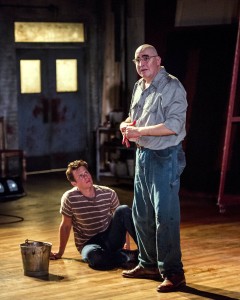 Via his subject, Logan imparts the kind of higher-thinking discourse that will prick up the ears of any audience member thirsting for intelligence and philosophical insight (the published play is dedicated to Stephen Sondheim). Most astounding is the accessibility and timelessness of Logan’s didactical display on all things art. Yet, while Logan does indeed create a vivid portrait of the Latvian-born artist – with his infamous petulance, fiery temper and volatility – the strikingly poetic script has little in the way of conflict and arc.
Via his subject, Logan imparts the kind of higher-thinking discourse that will prick up the ears of any audience member thirsting for intelligence and philosophical insight (the published play is dedicated to Stephen Sondheim). Most astounding is the accessibility and timelessness of Logan’s didactical display on all things art. Yet, while Logan does indeed create a vivid portrait of the Latvian-born artist – with his infamous petulance, fiery temper and volatility – the strikingly poetic script has little in the way of conflict and arc.
Still, much of the dialogue is the kind of juicy diatribe one would expect to hear if we could eavesdrop on a group of smoking and drinking avant-garde New York artists in the 1930’s: Rothko says, “Everyone likes everything nowadays. They like the phonograph and the soda pop and the shampoo and the Cracker Jack. Everything becomes everything else and it’s all nice and pretty and likeable. Everything is fun in the sun. But where’s the discernment? Where’s the arbitration that separates what I like from what I respect, what I deem worthy, what has… listen to me now…significance.”
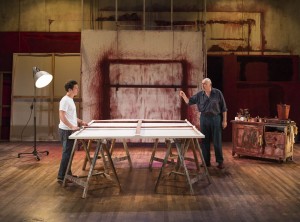 Without Molina’s performance as Rothko, the admonitions in the script that rail against society and its relationship to art—as delectable and fascinating as they are—could easily lose our attention. In Chicago at the Goodman last year, actor Edward Gero softened his approach to Rothko, creating a vulnerable, placid, subtly intense artist that only hinted at the painter’s unpredictability; as such, that production lacked a much-needed electricity. Molina—who played Rothko in the original London production—always has an air of threat about him, even when he’s soft-spoken. The painter is constantly gazing at his work, and in Molina’s eyes, we see bravado, fear, hubris, rapture, and distress—all as if he were looking at a lover. Alfred Molina’s performance is a work of art.
Without Molina’s performance as Rothko, the admonitions in the script that rail against society and its relationship to art—as delectable and fascinating as they are—could easily lose our attention. In Chicago at the Goodman last year, actor Edward Gero softened his approach to Rothko, creating a vulnerable, placid, subtly intense artist that only hinted at the painter’s unpredictability; as such, that production lacked a much-needed electricity. Molina—who played Rothko in the original London production—always has an air of threat about him, even when he’s soft-spoken. The painter is constantly gazing at his work, and in Molina’s eyes, we see bravado, fear, hubris, rapture, and distress—all as if he were looking at a lover. Alfred Molina’s performance is a work of art.
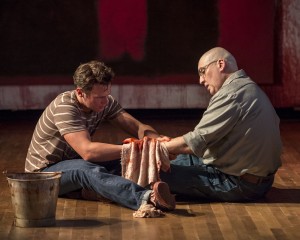 Based on true events, Red begins in 1958. Rothko has been commissioned to create a series of paintings for a swank New York restaurant in the new Seagram Building on Park Avenue (for a fortune, mind you). He claims his work will make the eatery a temple, but after visiting the space, he states that he hopes his art will ruin the appetite of every son-of-a-bitch that eats in there. But is Rothko a sell-out? This is the play’s main conflict. Without another conflict, Red could readily be a one-man show. As with Herbert Siguenza’s powerhouse solo show A Weekend With Pablo Picasso, the audience watching Red could have been easily assigned the role of art student or dealer or critic visiting a great painter’s studio.
Based on true events, Red begins in 1958. Rothko has been commissioned to create a series of paintings for a swank New York restaurant in the new Seagram Building on Park Avenue (for a fortune, mind you). He claims his work will make the eatery a temple, but after visiting the space, he states that he hopes his art will ruin the appetite of every son-of-a-bitch that eats in there. But is Rothko a sell-out? This is the play’s main conflict. Without another conflict, Red could readily be a one-man show. As with Herbert Siguenza’s powerhouse solo show A Weekend With Pablo Picasso, the audience watching Red could have been easily assigned the role of art student or dealer or critic visiting a great painter’s studio.
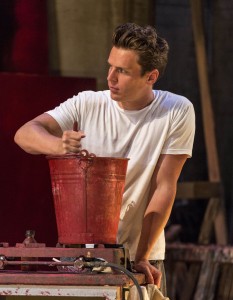 Therefore, Logan wisely creates the character of Ken, who assists Rothko on the project for two years in the artist’s Bowery studio. Ken is a Warhol-worshipper who wants to be a great painter himself, and Rothko uses the opportunity to forcefully impart his views on what makes an artist great. For example, he notes that you can’t discuss art without having read Nietzsche or Hamlet: “You cannot be an artist unless you are civilized. You cannot be civilized until you learn. To be civilized is to know where you belong in the continuum of your art and your world. To surmount the past, you must know the past.”
Therefore, Logan wisely creates the character of Ken, who assists Rothko on the project for two years in the artist’s Bowery studio. Ken is a Warhol-worshipper who wants to be a great painter himself, and Rothko uses the opportunity to forcefully impart his views on what makes an artist great. For example, he notes that you can’t discuss art without having read Nietzsche or Hamlet: “You cannot be an artist unless you are civilized. You cannot be civilized until you learn. To be civilized is to know where you belong in the continuum of your art and your world. To surmount the past, you must know the past.”
Indeed, it is Ken’s past – one that involves his parents’ death – that becomes the second conflict of the play; it also gives us insight into how Rothko himself deals with unpleasant memories: Rothko is almost dismissive towards Ken’s familial revelations; he is far more concerned with how those memories feed one’s art than in the memories themselves.
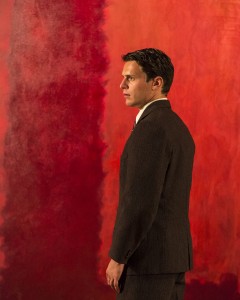 Logan acutely creates the relationship between Rothko and his art, but the relationship of Rothko and Ken is dramatically tricky for two reasons: quite often, Ken spends most of his time as a sounding board for Rothko’s sanctimonious preaching, and Ken is also used as a device to challenge Rothko’s motivation for accepting the restaurant commission, which gives the play its minimal arc. Because of these reasons, the actor playing Ken must be more than just capable. Jonathan Groff (Tony-nominated for Spring Awakening) didn’t seem to have the extraordinary inner machinery necessary to bring Ken to vivid life, at least not from row N. When Ken reveals his horrific background to Rothko, his confessional is related rather straightforward and restrained; in fact, it seemed as though Ken could have just as well related his tragic story to someone at the Chinese Restaurant where he orders the fiery painter’s food. Groff could certainly handle his own against the exquisite Mr. Molina, and they had a sterling rapport, but Groff—gorgeous and buff with incongruous Movie Star looks—delivers a performance that can be summed up as “fine” or “pretty good.” Rothko mentions his loathing for Ken’s neediness several times, but Groff’s expression of that neediness was much too low-key, and without that raw, burning internal life from Ken, the script’s didacticism becomes conspicuous, regardless of how brilliant that didacticism is (I can only imagine what Eddie Redmayne brought to the part that earned him a Tony Award.)
Logan acutely creates the relationship between Rothko and his art, but the relationship of Rothko and Ken is dramatically tricky for two reasons: quite often, Ken spends most of his time as a sounding board for Rothko’s sanctimonious preaching, and Ken is also used as a device to challenge Rothko’s motivation for accepting the restaurant commission, which gives the play its minimal arc. Because of these reasons, the actor playing Ken must be more than just capable. Jonathan Groff (Tony-nominated for Spring Awakening) didn’t seem to have the extraordinary inner machinery necessary to bring Ken to vivid life, at least not from row N. When Ken reveals his horrific background to Rothko, his confessional is related rather straightforward and restrained; in fact, it seemed as though Ken could have just as well related his tragic story to someone at the Chinese Restaurant where he orders the fiery painter’s food. Groff could certainly handle his own against the exquisite Mr. Molina, and they had a sterling rapport, but Groff—gorgeous and buff with incongruous Movie Star looks—delivers a performance that can be summed up as “fine” or “pretty good.” Rothko mentions his loathing for Ken’s neediness several times, but Groff’s expression of that neediness was much too low-key, and without that raw, burning internal life from Ken, the script’s didacticism becomes conspicuous, regardless of how brilliant that didacticism is (I can only imagine what Eddie Redmayne brought to the part that earned him a Tony Award.)
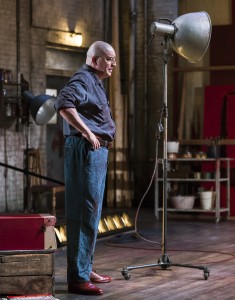 There is a scene which portends Rothko’s 1970 suicide. It’s fascinating to note that Robert Fall’s direction at the Goodman elicited an audible gasp from the audience. The way in which original director Michael Grandage staged it at the Taper soft-pedaled the moment, reducing any shock value whatsover. Yet, while the two actors at The Goodman had been responsible for a lulling experience, Grandage kept his actors on their toes. The evening felt somewhat rushed (running no less than 10 minutes shorter than Fall’s production), but the script really shined: its opinionated grandstanding, cerebral language, crackling dialogue, and the play’s examination of the intellectualism, psychology, and struggle behind art kept the audience engaged and provoked.
There is a scene which portends Rothko’s 1970 suicide. It’s fascinating to note that Robert Fall’s direction at the Goodman elicited an audible gasp from the audience. The way in which original director Michael Grandage staged it at the Taper soft-pedaled the moment, reducing any shock value whatsover. Yet, while the two actors at The Goodman had been responsible for a lulling experience, Grandage kept his actors on their toes. The evening felt somewhat rushed (running no less than 10 minutes shorter than Fall’s production), but the script really shined: its opinionated grandstanding, cerebral language, crackling dialogue, and the play’s examination of the intellectualism, psychology, and struggle behind art kept the audience engaged and provoked.
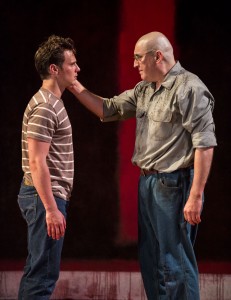 In the technical department, the Goodman triumphed over the Taper. The closing stage picture has Rothko examining one of his Seagram Mural Panels; the spectacular lighting and set design at the Goodman had the painting come alive with a glowing ferocity. Certainly, one can experience emotions gazing at a painting, but this moment elucidated how theatre can heighten that experience, and it was about as thrilling and breathtaking as theatre gets. Neil Austin’s Taper design was beautiful, but failed to enliven the paintings in the same way (this could have been Grandage’s choice). Christopher Orem’s representational set of a gymnasium-turned-studio is painstakingly detailed and beautifully executed, but the design seems better-suited for a proscenium house, not a thrust like the Taper.
In the technical department, the Goodman triumphed over the Taper. The closing stage picture has Rothko examining one of his Seagram Mural Panels; the spectacular lighting and set design at the Goodman had the painting come alive with a glowing ferocity. Certainly, one can experience emotions gazing at a painting, but this moment elucidated how theatre can heighten that experience, and it was about as thrilling and breathtaking as theatre gets. Neil Austin’s Taper design was beautiful, but failed to enliven the paintings in the same way (this could have been Grandage’s choice). Christopher Orem’s representational set of a gymnasium-turned-studio is painstakingly detailed and beautifully executed, but the design seems better-suited for a proscenium house, not a thrust like the Taper.
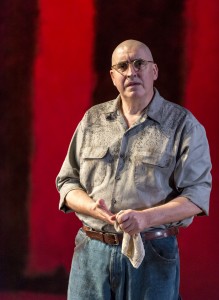 Rothko indicates a painting at the start of the play and asks Ken, “What do you see?” “Red,” the assistant answers back. The masterly painter then challenges him to see beyond “Red” and into the tragedy behind the colors. That opening question is also an invitation for audience members to look deeper into the art form before them. At a museum, a painting can be judged not just on its own merits, but its proximity to other paintings, the lighting, a docent’s explanatory notes, etc. Upon first glance, Red is an exquisite journey into the soul of an artist. It is intelligent, well-executed and enjoyable. But look closer. What will you see?
Rothko indicates a painting at the start of the play and asks Ken, “What do you see?” “Red,” the assistant answers back. The masterly painter then challenges him to see beyond “Red” and into the tragedy behind the colors. That opening question is also an invitation for audience members to look deeper into the art form before them. At a museum, a painting can be judged not just on its own merits, but its proximity to other paintings, the lighting, a docent’s explanatory notes, etc. Upon first glance, Red is an exquisite journey into the soul of an artist. It is intelligent, well-executed and enjoyable. But look closer. What will you see?
——————————
photos by Craig Schwartz
Red
Mark Taper Forum in Los Angeles
scheduled to end on September 9, 2012
for tickets, call 213.628.2772 or visit http://www.CenterTheatreGroup.org
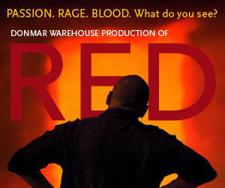

{ 1 comment… read it below or add one }
I saw the New York production, and have to tell you that the play worked better at the Taper – in part because of the relationship of Ken and Rothko. I thought Groff gave a much better performance than Redmayne. He made me understand why he stayed those two years as the assistant. Not only the respect but the genuine affection was more effectively rendered.
It’s certainly worth seeing again – which I plan to do.